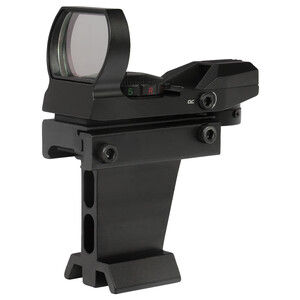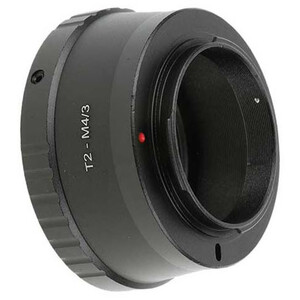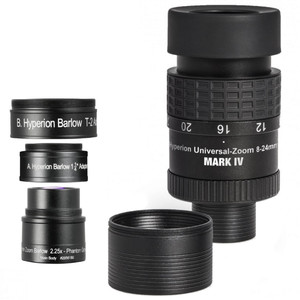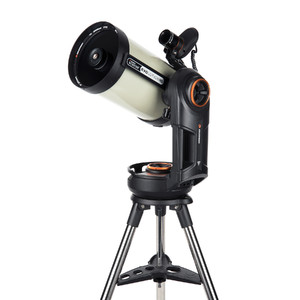This set offers you in a beautiful and sturdy metal box
- the eyepiece turret Q-Turret, with which you can quickly switch between up to four eyepieces or a camera by simply turning it.
- three orthoscopic eyepieces (6, 10 and 18mm) from the Classic Ortho series
- one Plössl eyepiece as a supplement for the longer focal length of 32mm
- the Q-Barlow lenses with 2.25x focal length extension
The set is very practical for the observation of planets: By turning the turret, you can quickly switch between the magnifications and thus adapt to the seeing conditions. The eyepiece turret also helps with planetary photography: first centre the planet or the desired lunar motif in the eyepiece, then switch to the camera by turning the turret. The additional optical length of the eyepiece turret is unproblematic when using SC telescopes.
The classic orthoscopic eyepiece has some advantages over popular Ploessl eyepieces of the same focal length, but especially compared to modern 'super-wide angle eyepieces':
- the low number of lens elements used results in very high light transmission with very high contrast and therefore gives an extremely clear, distortion-free image. The stars are perfectly sharp not only in the centre but also at the edge of the field of view.
- multi-coating ensures low internal reflections - separating the closest double stars with these eyepieces is a breeze, and the fine detail on planets emerges clearly.
- the orthoscopic eyepieces in this series are parfocal, i.e. almost no refocusing is needed when switching eyepieces.
Construction of an orthoscopic eyepiece: The optics consist of a plano-convex lens with a triplet, meaning there are only four air/glass surfaces. The interior is comprehensively blackened and effectively suppresses any stray light. In addition, the hard anodized barrel comes with an internal thread for taking filters.
The high-quality 2.25x Barlow lens made of special glass has the rare extension factor of 2.25. This means that with the eyepieces of the Q-Turret Set, no focal lengths are duplicated, and if you plan to take pictures of planets with a web or video camera later on, you will achieve a higher magnification than with normal 2x Barlow lenses and can make better use of the camera's resolution.
The Barlow can either be screwed into the Q-Turret eyepiece turret or combined with all 1.25" eyepieces using the special adaptor supplied. It then provides a magnification factor of 2.25x. This results in the following focal lengths on the Q-Turret eyepiece turret: 2.7 mm, 4.5 mm, 8 mm and 14 mm.
Alternatively, it can also be screwed directly into an eyepiece, increasing the telescope focal length by a factor of 1.3. The Barlow element has an M28.5 external thread (corresponding to the filter thread of 1.25" eyepieces), and the housing has an M28.5 internal thread. The factor of 1.3x is achieved when the Q-Barlow is screwed completely into the 24 mm long sleeve of an eyepiece whose field stop is 2 mm inside the sleeve. This corresponds to the design of the Classic Plössl/Ortho eyepieces; with other eyepiece designs, the magnification factor may vary slightly.
Please note: When fully screwed in, the Barlow element protrudes 13 mm into the 1.25" barrel. On eyepieces where lens elements in the 1.25" barrel prevent the Q-Barlow from being screwed in, it can only be used in the 1.25" adaptor with a factor of 2.25x.
Use with a planetary camera: The 2.25x Q Barlow lens (only the lens mount) can be screwed into any 1.25" filter thread. To do this, remove the lens part with the screw mount from the rest of the housing. Without the entire eyepiece mount, this Barlow (due to the reduction in path length between the lenses and the image plane) no longer has a factor of 2.25x but (when fully screwed in) "only" 1.3x.
However, it may not be possible to screw this lens mount in all the way – in which case the extension factor is approx. 1.5x.
However, if the 1.25" plug-in sleeve of the camera has an M28.5 filter thread cut into it, then you can usually screw the Barlow lens in completely, and the factor is then approx. 1.3x due to the short image distance. This capability is not accidental, but was the basic idea behind the design. At 2.25x, an image circle of 25 mm is vignette-free, and at a factor of 1.3x, this fully illuminated image circle is 13 mm.






